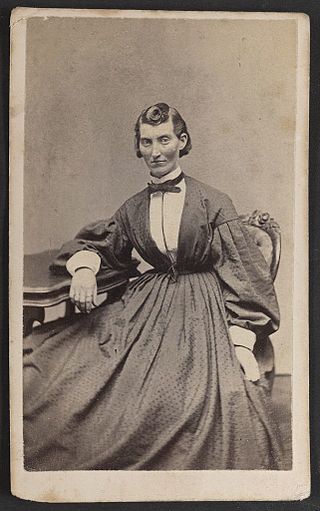
Cross-dressing is the act of wearing clothes traditionally or stereotypically associated with a different gender. From as early as pre-modern history, cross-dressing has been practiced in order to disguise, comfort, entertain, and express oneself.

Maria Isabella Boyd, best known as Belle Boyd was a Confederate spy in the American Civil War. She operated from her father's hotel in Front Royal, Virginia, and provided valuable information to Confederate General Stonewall Jackson in 1862.

Sarah Emma Edmonds was a British North America-born woman who claimed to have served as a man with the Union Army as a nurse and spy during the American Civil War. Although recognized for her service by the United States government, some historians dispute the validity of her claims as some of the details are demonstrably false, contradictory, or uncorroborated.

Mary Edwards Walker, commonly referred to as Dr. Mary Walker, was an American abolitionist, prohibitionist, prisoner of war, and surgeon. She is the only woman to receive the Medal of Honor.

Many people have engaged in cross-dressing during wartime under various circumstances and for various motives. This has been especially true of women, whether while serving as a soldier in otherwise all-male armies, while protecting themselves or disguising their identity in dangerous circumstances, or for other purposes.

Loreta Janeta Velázquez was an American woman who wrote that she had masqueraded as a male Confederate soldier during the American Civil War. The book she wrote about her experiences says that after her soldier husband's accidental death, she enlisted in the Confederate States Army in 1861. She then fought at Bull Run, Ball's Bluff, and Fort Donelson, but was discharged when her sex was discovered while in New Orleans. Undeterred, she reenlisted and fought at Shiloh, until unmasked once more. She then became a Confederate spy, working in both male and female guises, and as a double agent also reporting to the U.S. Secret Service. She remarried three more times, being widowed in each instance. According to William C. Davis, she died in January 1923 under the name Loretta J. Beard after many years away from the public eye in a public psychiatric facility, St. Elizabeths Hospital. Most of her claims are not supportable with actual documents, and many are contradictable by actual documentation.

Frances Louisa Clayton, also recorded as Frances Clalin, was an American woman who purportedly disguised herself as a man to fight for the Union Army in the American Civil War, though many historians now believe her story was likely fabricated. Under the alias Jack Williams, she claimed to have enlisted in a Missouri regiment along with her husband, and fought in several battles. She claimed that she left the army soon after her husband died at Stones River.

Women in World War I were mobilized in unprecedented numbers on all sides. The vast majority of these women were drafted into the civilian work force to replace conscripted men or to work in greatly expanded munitions factories. Thousands served in the military in support roles, and in some countries many saw combat as well.
Catherine Clinton is the Denman Professor of American History at the University of Texas at San Antonio. She specializes in American History, with an emphasis on the history of the South, the American Civil War, American women, and African American history.

Lorinda Anna Blair Etheridge was a Union nurse and vivandière who served during the American Civil War. She was one of only two women to receive the Kearny Cross. She was inducted into the Michigan Women's Hall of Fame in 2010.
During the American Civil War, sexual behavior, gender roles, and attitudes were affected by the conflict, especially by the absence of menfolk at home and the emergence of new roles for women such as nursing. The advent of photography and easier media distribution, for example, allowed for greater access to sexual material for the common soldier.
This article details the history of cross-dressing, the act of wearing the clothes of the sex or gender one does not identify with.
This is a timeline of women in warfare in the United States before 1900.This list includes women who served in the United States Armed Forces in various roles. It also includes women who have been Warriors and fighters in other types of conflicts that have taken place in the United States. This list should also encompass women who served in support roles during military and other conflicts in the United States before the twentieth century.
Charlotte Hatfield, also known as Charley Hatfield or "Mountain Charley", was a female soldier for the Union Army during the American Civil War.
This is a timeline of women in warfare in the United States up until the end of World War II. It encompasses the colonial era and indigenous peoples, as well as the entire geographical modern United States, even though some of the areas mentioned were not incorporated into the United States during the time periods that they were mentioned.
Sophronia Smith Hunt was an American woman who disguised herself as a man and secretly served as a soldier in the Union Army during the American Civil War. Her first soldier husband died after he was wounded at the Battle of Jenkins' Ferry. They served in the 29th Iowa Infantry Regiment.
Mary Owens fraudulently claimed to have served in disguise as a male Union soldier during the American Civil War.
Bibliography of works on the United States military and LGBT+ topics is a list of non-fiction literary works on the subject of the United States Armed Forces and LGBT+ subjects. LGBT+ includes any types of people which may be considered "Queer"; in other words, homosexual people, bisexual people, transgender people, intersex people, androgynous people, cross-dressers, questioning people and others.

Appolonia Jagiello, also known as Appolonia Jagiello Tochman, was a Polish-Lithuanian American revolutionary and activist. She is most notable for her direct participation in the 1846 Kraków uprising, the Hungarian Revolution, and for her tangential involvement in the American Civil War.









